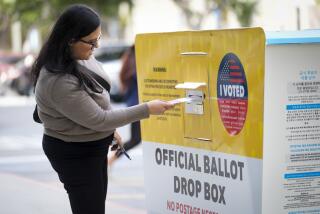Tough Stance a Change From Pre-City Days : 2 Slow-Growth Measures on Encinitas Ballot
- Share via
The city of Encinitas, born two years ago because of community anger over runaway growth, will have two slow-growth measures on the November ballot.
The City Council voted unanimously Wednesday night to place two measures calling for building caps on the ballot, along with a tie-breaking proposition meant to decide things if both measures pass.
Both measures place numerical limits on annual growth and attempt to shift power over growth from elected officials to the public. The council vote was a mere formality because both measures had received far more signatures during a petition campaign than were needed to qualify them for the ballot.
The competing measures are an indication of how the political fortunes in Encinitas have changed since cityhood--from the days of residents pleading with the Board of Supervisors and county Planning Department to slow growth, to an election in which voters can choose between two plans offering severe limits on residential and commercial building.
In the four years before Encinitas officially became a city Oct. 1, 1986, the population grew 35%. Along with deciding to incorporate in June, 1986, voters also elected a council dedicated to slowing growth.
Councilwoman Marjorie Gaines said the measure she co-sponsored with Mayor Rick Shea is a reaction to the pre-incorporation growth, which left Encinitas with clogged streets, crowded schools and a paucity of parkland, recreation facilities and library space.
The Gaines-Shea measure would take a figure considered to represent the ideal “build-out” population for Encinitas--based on a formula involving city services--then spread it out in roughly equal increments over 25 years.
Although no figure is contained in the measure, Gaines said it would be roughly 224 residential units a year, in a city with a current population of 52,000.
Once a General Plan is adopted, only voters could switch a residential area to non-residential use or vice-versa. Only voters could approve an increase in the permissible residential units per acre.
Only a four-fifths majority of the council could allow shifting from one non-residential use to another--from commercial to office buildings, for example, or industrial to public use.
Within commercial zones, however, no voter approval would be needed for further shopping centers--a controversial issue in a community that has seen several huge shopping centers spring up along El Camino Real in recent years.
Exemptions to the building cap would be granted to projects that, as of the day the measure becomes effective, already have permits, or in which developers have performed “substantial” construction or spent a “substantial” amount based on a “good faith” belief that City Hall approval would be forthcoming.
Decisions would be made “on a case-by-case basis by the city,” the measure says.
Gaines, in an interview, said she expects a “small stampede” by developers seeking permits before November. But she said she hopes the slowness of the City Hall process will prevent an ungainly number from qualifying for exemptions.
She said she believes that the measure is better researched and more legally defensible than the competing one written by Ray Jenkins, a teacher of history and government at San Diego Community College.
“Ray’s initiative is well-intentioned, but he came up with a fixed annual cap without a lot of research,” Gaines said.
Jenkins retorted that Gaines and her allies have apparently abandoned their concern for slow growth since taking office.
“Their measure is a bunch of wishes, with a sufficient number of loopholes to obviate any controls on growth,” he said. “Perhaps the luxury of city office has turned their interest.”
Jenkins’ measure calls for a 10-year cap, from 1989 to 1999, starting with 400 residential units in 1989, 350 in 1990, and 300 each year thereafter.
It provides fewer exemptions for residential building and tighter controls on commercial development.
Any commercial project of more than 48,000 square feet--roughly the size of the average supermarket--must be submitted to the voters. No commercial project can be allowed “until traffic congestion is eased,” the measure says.
In addition, the city in 1998 would be required to place before voters a five-year cap of 200 units a year.
A third measure put on the ballot by the City Council says that, in the event both measures pass, the one with the highest number of votes prevails. State law now requires that, in such cases, officials try to reconcile the two measures, following the one with the most votes when the two clash.
On one point Gaines and Jenkins agree: They wish Encinitas voters had had a chance to limit growth several years ago.
“We’d be a lot further along now in managing things,” Gaines said.
More to Read
Sign up for Essential California
The most important California stories and recommendations in your inbox every morning.
You may occasionally receive promotional content from the Los Angeles Times.










